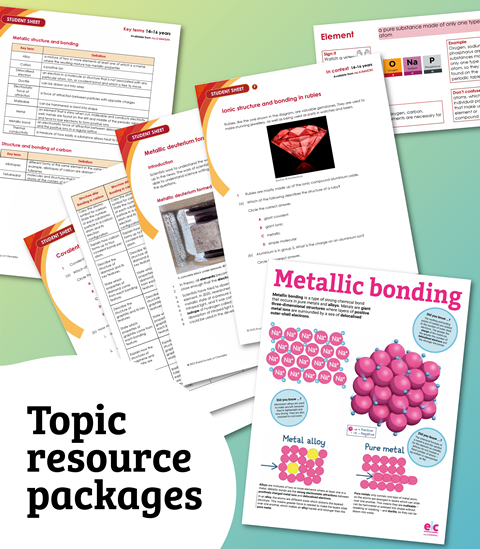All Group work articles – Page 7
-
 Lesson plan
Lesson planPlastics and polymers: their structure and properties | 16-18 years
Explore how the properties of polymers depend on their structure and different types of intermolecular bonds using this lesson plan for 16–18 year olds.
-
 Lesson plan
Lesson planTransition metal complexes and ligand exchange | 16-18 years
Try this lesson plan for 16–18 year olds to support your students to research transition metal complexes, including shape, naming, bonding and ligand exchange.
-
 Lesson plan
Lesson planExploring precipitation reactions using diagrams | 14-16 years
Discover how ions are arranged in precipitation reactions and practise completing ionic equations using this lesson plan with activities for 14–16 year olds.
-
 Lesson plan
Lesson planCatalysts, rates of reaction and what sank the Kursk | 14-16 years
Use the case of the Kursk submarine to devise an experimental investigation into catalysts’ effects on rate of reaction in this lesson plan for 14–16 year olds.
-
 Lesson plan
Lesson planInvestigating the chemistry of how fireworks work | 14-16 years
Explore the principles behind fireworks and what makes the different colours we see when they go off using this lesson plan with activities for 14–16 year olds.
-
 Lesson plan
Lesson planMolecules and the possibility of life in outer space | 14-16 years
Explore the molecules found in space as clues to the potential existence of extraterrestrial life, using this lesson plan with activities for 14–16 year olds.
-
 Lesson plan
Lesson planWhy do sediments form layers? | 11-14 years
Explore the layered formation of sedimentary rocks using this lesson plan and set of downloadable activities for 11–14 year olds.
-
 Lesson plan
Lesson planWhat is the rock cycle? | 11-14 years
Try this lesson plan and set of downloadable activities to help teach 11-14 year olds about sedimentary, metamorphic and igneous rocks and the rock cycle.
-
 Lesson plan
Lesson planConservation of mass in dissolving and precipitation | 11-14 years
Explore what happens during precipitation reactions and when substances dissolve using this lesson plan with downloadable activities for 11–14 year olds.
-
 Lesson plan
Lesson planUsing a survey to learn what shampoos people use | 11-14 years
Collect and analyse data from surveys, exploring differences between subjective and objective data, using this lesson plan with activities for 11–14 year olds.
-
 Lesson plan
Lesson planWhat are the effects of acid rain? | 11-14 years
Try this lesson plan for 11–14 year olds to investigate the effects of acid rain on metals and carbonate rocks through field work and an experiment.
-
 Lesson plan
Lesson planWhat happens when a substance changes state? | 11-14 years
Use this lesson plan for 11–14 year olds to explore what happens when substances warm, cool, boil or freeze, tackling misconceptions about changes of state.
-
 Lesson plan
Lesson planAcids and alkalis: using concept maps | 11–16 years
Help your students consolidate their ideas about acids and alkalis using this lesson plan and set of downloadable activities
-
 Lesson plan
Lesson planInvestigating the composition of limestone | 11-14 years
Use this lesson plan for 11–14 year olds to help your students plan, implement and evaluate a practical investigation to determine if all limestone is the same.
-
 Lesson plan
Lesson planMeasuring vitamin C in fruit using titration | 14-16 years
Compare the amount of vitamin C in fruit and juices using titration, and explore conditions affecting vitamin C levels, in this lesson plan for 14–16 year olds.
-
 Lesson plan
Lesson planWhat are crystals and how are they structured? | 11-14 years
Discover the regular structure and arrangement of particles in crystalline substances using this lesson plan with activities for 11–14 year olds.
-
 Lesson plan
Lesson planHow do shampoos work? Hair care, acids and bases | 14-16 years
Test shampoos and investigate their ingredients as an application of acid–base chemistry using this lesson plan with practical activities for 14–16 year olds.
-
 Lesson plan
Lesson planWhat are hydrogen bonds? | 16-18 years
Help students explore hydrogen bonding and discover where hydrogen bonds are found using this lesson plan with activities for 16–18 year olds.
-
 Lesson plan
Lesson planWhat are chemical reactions used for? | 11-14 years
Try this lesson plan for 11–14 year olds to explore how chemical reactions are used to produce energy, make new materials or support biological systems.
-
 Resource
ResourceWorking in groups | Principles of assessment for learning
Tips and strategies to make group work an effective part of lessons as well as a way of actively involving students in their learning.











